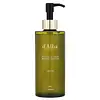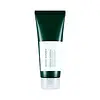What's inside
What's inside
 Key Ingredients
Key Ingredients

 Benefits
Benefits

 Concerns
Concerns

 Ingredients Side-by-side
Ingredients Side-by-side

Water
Skin ConditioningGlycerin
HumectantDisodium Cocoamphodiacetate
CleansingCoco-Glucoside
CleansingLauryl Glucoside
CleansingSodium Chloride
MaskingTea-Cocoyl Glutamate
CleansingAcrylates/C10-30 Alkyl Acrylate Crosspolymer
Emulsion StabilisingHexylene Glycol
EmulsifyingCitric Acid
BufferingChlorphenesin
AntimicrobialLavandula Angustifolia Oil
MaskingEthylhexylglycerin
Skin ConditioningButylene Glycol
HumectantXanthan Gum
EmulsifyingBetaine Salicylate
AntimicrobialSaccharide Isomerate
Humectant1,2-Hexanediol
Skin ConditioningCaprylyl Glycol
EmollientSalvia Officinalis Leaf Extract
CleansingSalix Alba Bark Extract
AstringentRosmarinus Officinalis Leaf Extract
AntimicrobialMentha Piperita Leaf Extract
Skin ConditioningLavandula Angustifolia Flower Extract
CleansingCarica Papaya Fruit Extract
Skin ConditioningAcetyl Hexapeptide-8
HumectantTuber Magnatum Extract
Skin ConditioningSodium Citrate
BufferingChamomilla Recutita Flower Extract
MaskingOcimum Basilicum Flower/Leaf/Stem Extract
TonicMelissa Officinalis Leaf Extract
Skin ConditioningMonarda Didyma Leaf Extract
Skin ConditioningMentha Suaveolens Leaf Extract
AstringentHibiscus Sabdariffa Flower Extract
Skin ConditioningRosa Centifolia Flower Extract
AstringentMentha Rotundifolia Leaf Extract
TonicLinalool
PerfumingWater, Glycerin, Disodium Cocoamphodiacetate, Coco-Glucoside, Lauryl Glucoside, Sodium Chloride, Tea-Cocoyl Glutamate, Acrylates/C10-30 Alkyl Acrylate Crosspolymer, Hexylene Glycol, Citric Acid, Chlorphenesin, Lavandula Angustifolia Oil, Ethylhexylglycerin, Butylene Glycol, Xanthan Gum, Betaine Salicylate, Saccharide Isomerate, 1,2-Hexanediol, Caprylyl Glycol, Salvia Officinalis Leaf Extract, Salix Alba Bark Extract, Rosmarinus Officinalis Leaf Extract, Mentha Piperita Leaf Extract, Lavandula Angustifolia Flower Extract, Carica Papaya Fruit Extract, Acetyl Hexapeptide-8, Tuber Magnatum Extract, Sodium Citrate, Chamomilla Recutita Flower Extract, Ocimum Basilicum Flower/Leaf/Stem Extract, Melissa Officinalis Leaf Extract, Monarda Didyma Leaf Extract, Mentha Suaveolens Leaf Extract, Hibiscus Sabdariffa Flower Extract, Rosa Centifolia Flower Extract, Mentha Rotundifolia Leaf Extract, Linalool
Water
Skin ConditioningGlycerin
HumectantPotassium Cocoyl Glycinate
Hydroxypropyl Starch Phosphate
Lauric Acid
CleansingDisodium Cocoamphodiacetate
CleansingLauryl Betaine
CleansingSodium Chloride
Masking1,2-Hexanediol
Skin ConditioningAsiatic Acid
Skin ConditioningAsiaticoside
AntioxidantButylene Glycol
HumectantCamellia Sinensis Leaf Extract
AntimicrobialCentella Asiatica Extract
CleansingCeramide NP
Skin ConditioningChamomilla Recutita Flower Extract
MaskingCitric Acid
BufferingCocos Nucifera Fruit Extract
EmollientDisodium EDTA
Glycyrrhiza Glabra Root Extract
BleachingHexylene Glycol
EmulsifyingHydrogenated Lecithin
EmulsifyingMadecassic Acid
Skin ConditioningMadecassoside
AntioxidantMoringa Oleifera Seed Oil
EmollientParfum
MaskingPentylene Glycol
Skin ConditioningPhytosphingosine
Skin ConditioningPinus Sylvestris Leaf Extract
TonicPolygonum Cuspidatum Root Extract
AntioxidantPotassium Chloride
Potassium Cocoate
EmulsifyingPropanediol
SolventPropolis Extract
Skin ConditioningRosmarinus Officinalis Leaf Extract
AntimicrobialScutellaria Baicalensis Root Extract
AstringentSodium Citrate
BufferingBenzyl Alcohol
PerfumingHexyl Cinnamal
PerfumingLimonene
PerfumingLinalool
PerfumingWater, Glycerin, Potassium Cocoyl Glycinate, Hydroxypropyl Starch Phosphate, Lauric Acid, Disodium Cocoamphodiacetate, Lauryl Betaine, Sodium Chloride, 1,2-Hexanediol, Asiatic Acid, Asiaticoside, Butylene Glycol, Camellia Sinensis Leaf Extract, Centella Asiatica Extract, Ceramide NP, Chamomilla Recutita Flower Extract, Citric Acid, Cocos Nucifera Fruit Extract, Disodium EDTA, Glycyrrhiza Glabra Root Extract, Hexylene Glycol, Hydrogenated Lecithin, Madecassic Acid, Madecassoside, Moringa Oleifera Seed Oil, Parfum, Pentylene Glycol, Phytosphingosine, Pinus Sylvestris Leaf Extract, Polygonum Cuspidatum Root Extract, Potassium Chloride, Potassium Cocoate, Propanediol, Propolis Extract, Rosmarinus Officinalis Leaf Extract, Scutellaria Baicalensis Root Extract, Sodium Citrate, Benzyl Alcohol, Hexyl Cinnamal, Limonene, Linalool
Ingredients Explained
These ingredients are found in both products.
Ingredients higher up in an ingredient list are typically present in a larger amount.
1,2-Hexanediol is a synthetic liquid and another multi-functional powerhouse.
It is a:
- Humectant, drawing moisture into the skin
- Emollient, helping to soften skin
- Solvent, dispersing and stabilizing formulas
- Preservative booster, enhancing the antimicrobial activity of other preservatives
Butylene Glycol (or BG) is used within cosmetic products for a few different reasons:
Overall, Butylene Glycol is a safe and well-rounded ingredient that works well with other ingredients.
Though this ingredient works well with most skin types, some people with sensitive skin may experience a reaction such as allergic rashes, closed comedones, or itchiness.
Learn more about Butylene GlycolChamomilla Recutita Flower Extract comes from the Chamomile flower.
Chamomile is rich in antioxidants and has anti-inflammatory properties. Several compounds found in chamomile help with soothing, such as bisbolol.
Antioxidant components in chamomile make it an effective ingredient to help slow the signs of aging. Antioxidants help fight free-radical molecules, or molecules that may damage your skin.
Essential oils from chamomile have been found to improve wound healing due to its antimicrobial properties.
Ancient Greeks and Egyptians used Chamomile to treat skin redness and dryness. Chamomile has also been used to help treat stomach issues.
Learn more about Chamomilla Recutita Flower ExtractCitric Acid is an alpha hydroxy acid (AHA) naturally found in citrus fruits like oranges, lemons, and limes.
Like other AHAs, citric acid can exfoliate skin by breaking down the bonds that hold dead skin cells together. This helps reveal smoother and brighter skin underneath.
However, this exfoliating effect only happens at high concentrations (20%) which can be hard to find in cosmetic products.
Due to this, citric acid is usually included in small amounts as a pH adjuster. This helps keep products slightly more acidic and compatible with skin's natural pH.
In skincare formulas, citric acid can:
While it can provide some skin benefits, research shows lactic acid and glycolic acid are generally more effective and less irritating exfoliants.
Most citric acid used in skincare today is made by fermenting sugars (usually from molasses). This synthetic version is identical to the natural citrus form but easier to stabilize and use in formulations.
Read more about some other popular AHA's here:
Learn more about Citric AcidDisodium Cocoamphodiacetate is a surfactant and helps cleanse skin. It is created from the fatty acids of coconut oil.
Surfactants help rinse oil, dirt, and other pollutants easily from skin. It has a faint fruit-like scent.
Glycerin is already naturally found in your skin. It helps moisturize and protect your skin.
A study from 2016 found glycerin to be more effective as a humectant than AHAs and hyaluronic acid.
As a humectant, it helps the skin stay hydrated by pulling moisture to your skin. The low molecular weight of glycerin allows it to pull moisture into the deeper layers of your skin.
Hydrated skin improves your skin barrier; Your skin barrier helps protect against irritants and bacteria.
Glycerin has also been found to have antimicrobial and antiviral properties. Due to these properties, glycerin is often used in wound and burn treatments.
In cosmetics, glycerin is usually derived from plants such as soybean or palm. However, it can also be sourced from animals, such as tallow or animal fat.
This ingredient is organic, colorless, odorless, and non-toxic.
Glycerin is the name for this ingredient in American English. British English uses Glycerol/Glycerine.
Learn more about GlycerinHexylene Glycol is a surfactant. Glycols are a class of alcohols. Hexylene Glycol is a surfactant and emulsifier.
As a surfactant, Hexylene Glycol helps gather dirt and oil on your skin to be washed away.
As an emulsifier, Hexylene Glycol helps keep water and oil together. This prevents them from separating in a product. Hexylene Glycol also thins out the texture of a product by lessening viscosity.
Hexylene Glycol has a small molecular weight.
Learn more about Hexylene GlycolLinalool is a fragrance and helps add scent to products. It's derived from common plants such as cinnamon, mint, citrus, and lavender.
Like Limonene, this ingredient oxidizes when exposed to air. Oxidized linalool can cause allergies and skin sensitivity.
This ingredient has a scent that is floral, spicy tropical, and citrus-like.
Learn more about LinaloolRosmarinus Officinalis Leaf Extract comes from rosemary. Rosemary is native to the Mediterranean.
While Rosmarinus Officinalis Leaf Oil can be volatile due to its fragrant properties, the fragrance components are usually removed in the leaf extract.
Rosemary Leaf Extract contains many antioxidants such as rosmarinic acid and caffeic acid. Rosemarinic acid, a compound found in rosemary leaf, has been found to help soothe skin conditions such as eczema and acne.
Learn more about Rosmarinus Officinalis Leaf ExtractChances are, you eat sodium chloride every day. Sodium Chloride is also known as table salt.
This ingredient has many purposes in skincare: thickener, emulsifier, and exfoliator.
You'll most likely find this ingredient in cleansers where it is used to create a gel-like texture. As an emulsifier, it also prevents ingredients from separating.
There is much debate on whether this ingredient is comedogenic. The short answer - comedogenic ratings don't tell the whole story. Learn more about comegodenic ratings here.
The concensus about this ingredient causing acne seems to be divided. Research is needed to understand if this ingredient does cause acne.
Scrubs may use salt as the primary exfoliating ingredient.
Learn more about Sodium ChlorideSodium Citrate is the sodium salts of citric acid. In skincare, it is used to alter pH levels and acts as a preservative.
Its main functions are to maintain the pH of a product and neutralize metal ions.
The acidity of our skin is maintained by our glands and skin biome; normal pH level of skin is slightly acidic (~4.75-5.5).
Being slightly acidic allows our skin to create an "acid mantle". This acid mantle is a thin barrier that protects our skin from bacteria and contaminants.
Learn more about Sodium CitrateWater. It's the most common cosmetic ingredient of all. You'll usually see it at the top of ingredient lists, meaning that it makes up the largest part of the product.
So why is it so popular? Water most often acts as a solvent - this means that it helps dissolve other ingredients into the formulation.
You'll also recognize water as that liquid we all need to stay alive. If you see this, drink a glass of water. Stay hydrated!
Learn more about Water